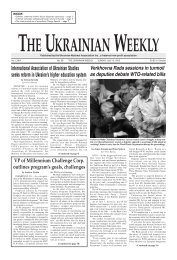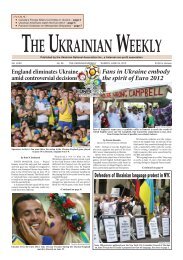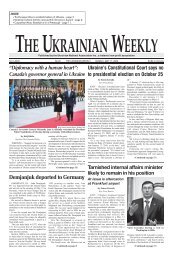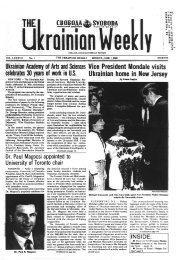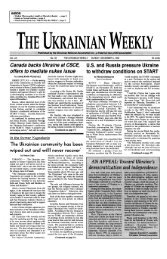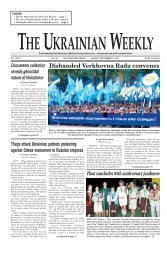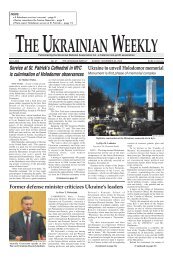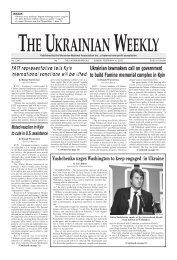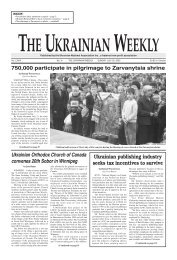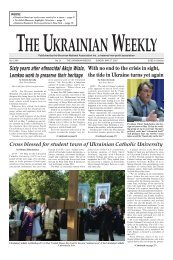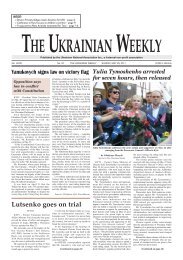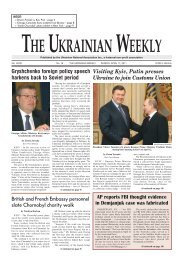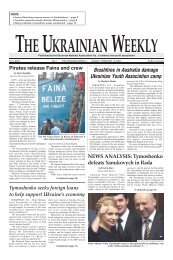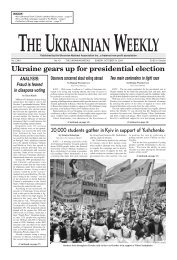Tymoshenko supporters block Rada presidium - The Ukrainian Weekly
Tymoshenko supporters block Rada presidium - The Ukrainian Weekly
Tymoshenko supporters block Rada presidium - The Ukrainian Weekly
Create successful ePaper yourself
Turn your PDF publications into a flip-book with our unique Google optimized e-Paper software.
No. 50<br />
THE UKRAINIAN WEEKLY SUNDAY, DECEMBER 11, 2011<br />
9<br />
Cover of the exhibit’s bilingual catalogue.<br />
<strong>The</strong> DP to DC exhibit committee with speakers (from left): Dr. George Hrycelak,<br />
vice-president of the <strong>Ukrainian</strong> National Museum; Dr. Lubomyr Luciuk, speaker;<br />
Bohdan Dudycz, member of the UNM board of directors; Dr. Mark Wyman, speaker;<br />
Orest Hrynewych, vice-president of the UNM.<br />
UNM<br />
President Jaroslaw J. Hankewych of the<br />
<strong>Ukrainian</strong> National Museum.<br />
<strong>Ukrainian</strong> National Museum opens “From DP to DC” exhibit<br />
Dr. Mark Wyman (left) and Dr. Lubomyr Y. Luciuk speak at the exhibit opening.<br />
by Orest A. Hrynewych<br />
CHICAGO – Old friends reconnected, acquaintances<br />
were renewed and half-forgotten memories became vivid<br />
again at the “From DP to DC” exhibit, formally called<br />
“Displaced Persons: A Story of <strong>Ukrainian</strong> Refugees in<br />
Europe 1945-1952.’’<br />
<strong>The</strong> exhibit opened on November 4-6, at the <strong>Ukrainian</strong><br />
National Museum (UNM) of Chicago and the exhibit continues<br />
through January 31, 2012.<br />
By all accounts the opening weekend of the exhibit<br />
was a huge success. People recognized long lost friends<br />
on photographs and commented how thin and young<br />
they looked. <strong>The</strong>re was a spirit of familiarity in the air<br />
and a congenial atmosphere prevailed.<br />
<strong>The</strong> primary objective of this exhibit was to honor the<br />
efforts of the Third Wave of <strong>Ukrainian</strong> immigrants to the<br />
new world and more specifically their accomplishments<br />
in Chicago. <strong>The</strong> exhibit attempted to show how this experience<br />
was turned into something positive that helped<br />
new <strong>Ukrainian</strong> immigrants to quickly adopt an organized<br />
and productive life in America.<br />
A secondary objective was to present to the public a<br />
user-friendly exposition of all aspects of the DP experience.<br />
As one viewer stated, “DP camps were the boot<br />
camps to prepare immigrants for life in America.”<br />
<strong>The</strong> idea for this exhibit was first discussed over a year<br />
and a half ago at a regular meeting of the UNM executive<br />
board. <strong>The</strong> board of directors members noted that the<br />
drama of displaced persons was too important to forget.<br />
<strong>The</strong> UNM saw an opportunity to educate the general public,<br />
descendants of Third Wave refugees, as well as Fourth<br />
Wave immigrants who were not familiar with the history<br />
of their predecessors.<br />
<strong>The</strong> exhibit was carefully formulated to be inviting and<br />
interactive. <strong>The</strong> exhibit hall was arranged in a logical<br />
chronological fashion, starting with the reasons for the<br />
refugees as a result of World War II and ending in the<br />
success stories of a select number of Third Wave<br />
<strong>Ukrainian</strong>s.<br />
Orest A. Hrynewych is first vice-president of the<br />
<strong>Ukrainian</strong> National Museum.<br />
A section was devoted to the forced repatriation of<br />
<strong>Ukrainian</strong>s and its tragic consequences, as well as the<br />
actions of Gen. Dwight D. Eisenhower and Eleanor<br />
Roosevelt in terminating forced repatriation.<br />
A huge map of the DP camps in Germany and Austria<br />
was provided and people were invited to locate their DP<br />
camps and indicate so by inserting a pin in the map.<br />
This was followed by an overview of the Immigration<br />
Act of 1948 and the part played by Harry S. Truman in getting<br />
this law passed. Next was a story of the Ellis Island<br />
experience.<br />
Another wall described camp life and its important<br />
aspects. Nine large canvas banners described DP camp<br />
administration, religious activity, education, youth organizations,<br />
sports, health and nutrition, publications, artistic life<br />
and the theater. Below the banners were display cases with<br />
DP camp artifacts, donated by the <strong>Ukrainian</strong> public, which<br />
provided supportive links with the banner’s subject matter.<br />
One wall was devoted to the Regensburg DP Camp,<br />
which was very active and whose residents are well represented<br />
in Chicago. Of special interest was the exhibit of<br />
Plast uniforms, emblems, banners and badges of the<br />
<strong>Ukrainian</strong> scouts in Regensburg.<br />
Another wall was designated “Living Memory” – a place<br />
for former DP camp residents to write their names, professions,<br />
their DP camps, years and the means of transport to<br />
America. A portion of the wall also contained the biographies<br />
of some of the prominent local <strong>Ukrainian</strong> DPs who<br />
have made successes of their lives in America.<br />
<strong>The</strong> pièce de résistance was a typical DP camp room<br />
recreated with a bunk bed, old clothing and actual everyday<br />
articles from the UNM permanent collection and from<br />
items donated or loaned to the museum from interested<br />
<strong>Ukrainian</strong>s from all over America. <strong>The</strong> museum is especially<br />
thankful for the astonishing response from former DPs<br />
who saved these priceless relics from the bygone years in<br />
German and Austrian DP camps.<br />
Jaroslaw Hankewych, the president of the <strong>Ukrainian</strong><br />
National Museum, introduced the “From DP to DC’’ exhibit<br />
to a standing-room-only crowd on Friday, November 4. A<br />
short explanation of the purpose of the exhibit and the best<br />
way to view was provided by Maria Klimchak, the curator.<br />
<strong>The</strong>re were two invited speakers.<br />
Prof. Mark Wyman, author of “DPs: Europe’s Displaced<br />
Persons, 1945-1951,” spoke eloquently on the subject of<br />
his introduction to DPs and <strong>Ukrainian</strong>s DPs’ unique struggle<br />
for recognition as a separate stateless people who have<br />
maintained their national heritage and culture.<br />
<strong>The</strong> second speaker was Dr. Lubomyr Y. Luciuk, author<br />
of “Searching for Place: <strong>Ukrainian</strong> Displaced Persons,<br />
Canada and the Migration of Memory.” He challenged the<br />
audience to educate the public about the great injustice of<br />
forced repatriation of the DPs and the crimes committed<br />
by Communists that still are not acknowledged. He suggested<br />
that the <strong>Ukrainian</strong> community should seek, if not<br />
redress, an understanding of these tragic events inflicted<br />
on the <strong>Ukrainian</strong> nation and is people.<br />
<strong>The</strong> speeches were well received and followed by a lively<br />
question and answer period. <strong>The</strong> opening night’s program<br />
was repeated on Saturday, November 5, to a smaller crowd.<br />
On Sunday, November 6, Dr. Myron B. Kuropas, author<br />
of “<strong>The</strong> <strong>Ukrainian</strong> Americans: Roots and Aspirations 1898-<br />
1954,” and other books on <strong>Ukrainian</strong> subjects, presented a<br />
talk on “How the Immigration Act of 1948 Almost Did Not<br />
Happen,” to a lively crowd. His presentation was followed<br />
by a lengthy question and answer period.<br />
One of the firsts for the UNM was the publication of a<br />
bilingual catalogue of the exhibit titled “From DP to DC,<br />
Displaced Persons: A story of <strong>Ukrainian</strong> Refugees in<br />
Europe 1945-1952.” Copies of this catalogue are available<br />
for $25 from the administrator of the <strong>Ukrainian</strong> National<br />
Museum of Chicago, 2249 W. Superior St., Chicago, Ill.,<br />
6061; phone, 312-421-8020; fax, 773-772-2883; e-mail,<br />
info@ukrainiannationalmuseum.org.<br />
<strong>The</strong> exhibit was made possible through the generous<br />
support of <strong>The</strong> Heritage Foundation of First Security<br />
Federal Savings Bank and <strong>The</strong> Selfreliance Foundation of<br />
Selfreliance <strong>Ukrainian</strong> American Federal Credit Union.<br />
<strong>The</strong> exhibit runs from November 4, 2011 through<br />
January 2012. Museum hours are Thursday through<br />
Sunday, 11 a.m. to 4 p.m.<br />
<strong>The</strong> exhibit and the accompanying exhibit catalogue<br />
were prepared by the exhibit committee, composed of<br />
Bohdan Dudycz, George Hrycelak, Orest Hrynewych, UNM<br />
board members, Ms. Klimchak and the museum’s administrator,<br />
Anna Chychula.



